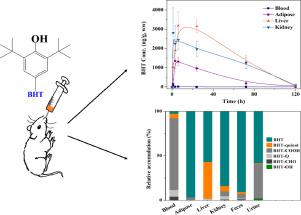Science of the Total Environment ( IF 8.2 ) Pub Date : 2020-06-01 , DOI: 10.1016/j.scitotenv.2020.139862 Ruirui Zhang 1 , Juying Li 2 , Xinyi Cui 1

|
As one typical synthetic phenolic antioxidant, 2,6-Di-tert-butyl-hydroxytoluene (BHT) has been widely adopted in food and other human products, and considered as an emerging contaminant due to its toxic effects. Understanding bioaccumulation and metabolism of BHT is crucial to evaluate its environmental fate and toxicity. In this study, the tissue distribution, excretion, and metabolism of BHT in mice were investigated. It was shown that BHT was prone to be accumulated in metabolism-related organs (i.e., liver and kidney) with AUC0–120 h (area under the concentration-time curve from 0 to 120 h) values of 206 h·μg/g in liver and 162 h·μg/g in kidney. For metabolites, 2,6-di-tert-butyl-4-hydroxy-4-methyl-2,5-cyclohexadione (BHT-quinol) was preferentially accumulated in liver, while 3,5-di-tert-butyl-4-hydroxybenzoic acid (BHT-COOH) was the major metabolite in excreta. The major excretion of BHT and metabolites was through feces with a value of 25.1 ± 0.16% of the initial dose compared with urine of 1.27 ± 0.05%. The possible metabolic pathways of BHT were elucidated as the oxidation of the para-methyl, tert-butyl groups, and aromatic ring based on the known and identified unknown metabolites by HPLC-Q-TOF-MS/MS. The preferred accumulation of BHT and metabolites in liver implies their potential hepatotoxicity. Results here also suggested that considering the distribution and excretion of metabolites can better assess BHT's fate and risk in mammals.
中文翻译:

2,6-二叔丁基-羟基甲苯在小鼠中的组织分布,排泄和代谢。
作为一种典型的合成酚类抗氧化剂,2,6-二叔丁基-羟基甲苯(BHT)已广泛用于食品和其他人类产品中,由于其毒性作用而被视为新兴污染物。了解BHT的生物积累和代谢对于评估其环境命运和毒性至关重要。在这项研究中,对小鼠中BHT的组织分布,排泄和代谢进行了研究。结果表明,BHT易于在代谢相关器官(即肝和肾)中积累,AUC为0-120 h(浓度-时间曲线下面积为0-120 h)为206 h·μg/ g在肝脏中为162 h·μg/ g。对于代谢物,2,6-二-叔-丁基-4-羟基-4-甲基-2,5-环己二酮(BHT-quinol)优先在肝脏中积累,而3,5-二叔丁基-4-羟基苯甲酸(BHT-COOH)是主要的排泄物中的代谢产物。BHT和代谢产物主要通过粪便排泄,其排泄量为初始剂量的25.1±0.16%,而尿液的排泄量为1.27±0.05%。阐明了BHT可能的代谢途径是对甲基,叔丁基的氧化-丁基和基于已知和鉴定的未知代谢产物的芳环(通过HPLC-Q-TOF-MS / MS)。BHT和代谢物在肝脏中的优先积累意味着它们潜在的肝毒性。此处的结果还表明,考虑代谢产物的分布和排泄可以更好地评估哺乳动物中BHT的命运和风险。






























 京公网安备 11010802027423号
京公网安备 11010802027423号